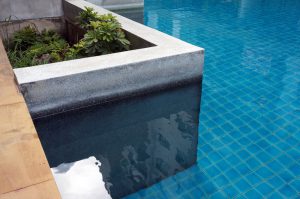How To Remove Swimming Pool Stains

Pools here in Texas are quite common, as we have to find a way to escape the Texas summer heat. A pool is a great way to keep cool, spend time with your friends and family, keep your kids entertained, add major aesthetic appeal to your backyard, and add investment value to your home. To keep your pool in swimmable condition and looking beautiful requires maintenance. A pool that is dirty or contains stains can become unsafe to swim in and is not nice to look at.
It is natural for pool stains to appear over time. Regular maintenance and proper cleaning can help keep these stains at bay, however sometimes they are just inevitable. Certain pool stains are pretty simple to get rid of while others can prove to be quite difficult. Knowing what the stains are, where they came from, and how they got there will help you with the removal of those stains. Often these stains on the walls or floor of your swimming pool can be caused by either metal in the water or certain materials left in the pool such as leaves and dirt. Your first indicator of a stain will likely be its color. Follow these steps to diagnose and remove pool stains:
Step #1 Identify the color of the stain in order to categorize the cause
Identifying the color of the stain in your pool will help you classify the cause of the stain. There are two main categories of pool stains, being metal stains and organically-caused stains. There are a few color combinations to look out for: greenish-brown, reddish-blue, blue-green-black, greenish-brown-red, pinkish-red, brown-black-purple. Look at the stain closely to try and categorize the color combination.
Step #2 Checking if your pool stains are organically-caused
Pool stains that are organically caused are usually a result of dirt and debris like leaves, algae, worms, berries, dead animals, etc. Removing this type of debris right away will prevent these stains. However, if the debris isn’t removed from the top it will sink to the bottom causing these stains. Organic stains are usually greenish, brownish, or bluish-purple. If you still see the debris on the bottom of the floor this may be a clear sign.
To remove the organic stain:
- You will want to first make sure your pool is clear of all debris. Next, you will want to try taking a small amount of chlorine and applying it directly onto the stain. Take a soft brush and lightly scrub the stain. Usually organic stains will resolve easily from this action and metal ones will not.
- If the stains seem more permanent, you may want to try acid washing your pool. Only engage in acid washing your pool about every five years or you could cause permanent damage to the plaster of your pool.
- You can also try an enzyme shock treatment along with a hard-bristled scrub brush to remove organic stains. This is best for when the stain is around the waterline of the pool.
- Try shocking your pool with chlorine. Another way to remove organic stains is by shocking your pool. After the shocking process, use a brush to scrub the stains. You should only try this with plaster pools. If you aren’t sure of the material of your pool, you may want to ask your pool builder in Hurst.
- Try muriatic acid and scrub brush. Pour the acid onto a piece of PVC pipe and then onto the stain and scrub gently. Afterwards you will want to shock your pool.
Step #3 Checking if the stain is metal-based or caused by some other inorganic substance
Corrosion is natural over time with any metal substances involved. Various metals that can lead to metal stains are rust, manganese, copper, and iron. The most common metal substances that cause pool stains are iron, copper, and manganese. The smallest amount of copper can become oxidized in your pool and leave behind difficult stains. Pipes and ladders and other exposed metals can lead to these types of stains. Poor pool maintenance can also contribute to the formation of metal stains as well.
While knowing the exact metal that caused the stain is necessary for removal, these types of stains most often require the professional assistance. You will likely need to take a water sample in or have someone come to you. A special additive will need to be prescribed in order to move the metal stains.
To remove the metal stain:
- Buy a metal removal product for your skimmer basket. This product will sit in your skimmer for up to a month.
- Try removing metal stains with ascorbic acid. You can add the acid evenly to the pool water (about a ½ pound per 10,000 gallons in the pool). Set your filter to circulate and turn on. Leave it for half an hour and then check to see if your stains are gone. Try again for another half hour if you still see stains.
- Make sure you have a healthy chemical balance in your pool. This is very important to ensure that your pool doesn’t stain permanently. Making sure all the chemicals are balanced will help in the relief of stains.
One way to ensure your pool doesn’t suffer from stains is by engaging in regular pool maintenance. Mid City Custom Pools is a highly recommended and trusted pool company and swimming pool builder in Hurst. If you have any questions or are interested in building the pool of your dreams, contact us today.
